Books
George Washington's Teeth
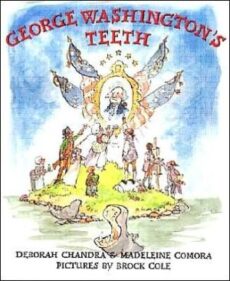
In a clever approach to history, Chandra and Comora string together spry stanzas describing the dental difficulties that plagued George Washington. Rhyming verse explains how the general's rotten teeth gradually fall out during the Revolutionary War: “George crossed the icy Delaware/ With nine teeth in his mouth./ In that cold and pitchy dark,/ Two more teeth came out!” Cole complements this verse by rendering a sly watercolor twist on Emanuel Leutze's famous painting George Washington Crossing the Delaware, in a full-spread treatment: Washington still stands in quiet dignity, but the boatmen are grinning. By the time Washington is elected president, just two teeth remain in his mouth. Kids will love the details, such as the way Washington uses a pair of his molars to fashion a mold from which the dentist makes a set of dentures (these are carved from hippopotamus ivory, and even shown, in a photograph in the afterword). Infusing his bustling watercolor vignettes with comic hyperbole, Cole easily keeps pace with the lighthearted narrative. One especially funny image shows the president sprawled on the floor, legs in the air, after viewing a newly painted portrait (“George stood up to have a look-/ He fell back on his fanny./ 'It doesn't look like me!' he roared./ 'It looks like Martha's granny!'”). An annotated timeline at the end includes quotes from the leader's letters and diaries chronicling his relentless efforts to hide his dental problems and the extent to which they caused him chronic pain and embarrassment. A highly palatable historical morsel for all ages. [From Publishers Weekly]
Fresh & Fun: Teeth
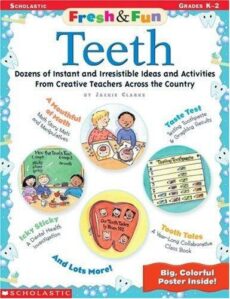
“Brush up” on teaching about teeth and dental health with these fun and easy activities! Kids will love making a timeline to track lost teeth, playing the memory game, “Look What the Tooth Fairy Left,” and mapping tooth traditions around the world. Plus: a read-aloud fable, pocket chart activities, dental health finger-plays, “Tooth or False” reproducible game board, book links, computer connections, and a big, colorful poetry poster!
How Many Teeth? Let's-Read-and-Find-Out Science 1

How many teeth does one have during the various stages of life? That is the premise in this introduction that has been a mainstay in libraries serving children for nearly 30 years (HarperCollins, 1962). The update is long overdue. Changes in text are slight; the big transformation is in the book's overall appearance. The characters have been given an updated, more cartoon-like look, with new hairstyles and casual clothing. Gender and ethnic representation is more balanced, and the figures are more active. A baby formerly being held and fed is now feeding himself a bottle, Elizabeth has escaped her confining highchair, and readers see Sam brushing his teeth morning and night, rather than just a sketch of the sun and moon. But the biggest change is in the parents. Yesterday's stay-at-home Mom, in bathrobe, rollers, and lipstick, and Dad, in his business suit, have been replaced by a couple enjoying themselves at a picnic. Full-color watercolors replace Galdone's two-color drawings. All contribute to a striking uplift for an old standby, worth serious consideration. [From School Library Journal]
Throw Your Tooth on the Roof: Tooth Traditions from Around the World
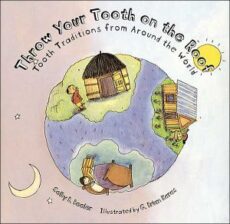
Children from countries on each continent explain what they do when they lose a tooth, including throwing their teeth on the roof. PW called this volume “an eye-opener for young Americans who may have assumed that the Tooth Fairy holds a worldwide visa.” [From Publishers Weekly]
Clarabella's Teeth
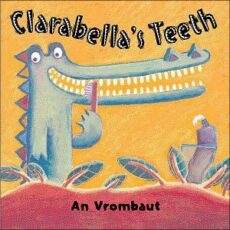
An amusing story about the importance of carefully brushing your teeth and the satisfaction gained by helping a friend. When Clarabella, a crocodile, and her friends wake up, they start the day by brushing their teeth. The monkey, the zebra, the rabbit, and the leopard get the job done quickly while Clarabella “brushes and brushes and brushes” all of her teeth. Her friends play, have lunch, build sand castles, nibble ripe mangoes, and leap and spin around. As they move through their day, the question, “And Clarabella?” tempts readers to turn each page. By the time she is ready to join the fun, the other creatures are getting ready for bed. Poor Clarabella sighs, but then her friends surprise her with a large toothbrush. Delighted with her gift, the young crocodile turns her sigh into a big smile. The animals are playfully illustrated; the zebra sports pink and purple stripes, the monkey is done in green and purple, the rabbit is bright red with a green outline, and the leopard has green spots. This quirky and bright artwork, executed in pastels, is eye-catching and funny. [From School Library Journal]
Up Close: Teeth That Stab and Grind

This fine entry focuses on how teeth are used by many different animals for chomping, grinding, stabbing, etc. Each chapter has two pages of readable text; crisp, color photos; and small, captioned, ink-and-watercolor drawings. The facts and photos have been carefully selected to entertain and astonish children. The wide-open mouths of a hippo and a viperfish are sure to draw oohs and aahs. The writing style is conversational and clear. Despite the index, this is not primarily a research tool. It is enjoyable enough to read cover-to-cover-and just may keep kids awake during Dental Health Week. [From School Library Journal]
Tooth Tales from Around the World
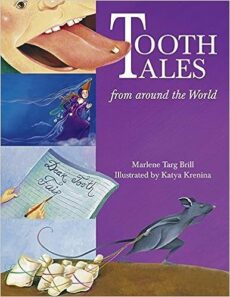
Putting a baby tooth under a pillow and getting money from the tooth fairy is an American tradition. But as Brill explains, many other cultures, much older than ours, have also had traditions about lost teeth. Ancient Egyptians believed the sun made teeth strong, so they threw lost teeth toward the sun. In the Middle Ages, parents ground children's teeth down into a powder and ate it, to protect their children from wicked witches. Perhaps the most common tradition, besides the tooth fairy, comes from Europe, where more than 100 years ago, children began to receive small gifts from the “tooth mouse,” an evolution that probably began when children and adults threw teeth in mouse holes in the hope that the kids would grow sharp teeth. The transitions from subject to subject can be a bit vague; however, the information presented is very interesting. The paintings, suffused with whimsy, are eye-catching, though some children may prefer their nonfiction art more true to life. Still, this should have appeal for kids, especially those going through the loose-tooth stage themselves. [From BookList, 1998]
The Right Bite: Dentists as Detectives
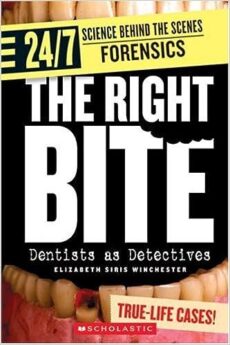
In line with their lurid titles, these concise, high-interest introductions to various branches of forensic science include three case studies each, along with descriptions of methods, necessary gear, interviews with practitioners of both sexes, and even career advice, along with plenty of photos that are more suggestive than icky. Describing how criminal profilers work, Beres shows how the Mad Bomber of the 1940s and 1950s, a later murderer, and a computer hacker were identified through keen observation and psychological analysis, in contrast, as Winchester explains, to serial killer Ted Bundy, who was identified in part by a bite mark he left on a victim. Denega shows how forensic entomologists use insect evidence to narrow down the times of criminal and other deaths. Written to a template but with only minor quantities of boilerplate, these quick scans will both rivet and inform true-crime fans — and may even spark some vocational interest in their diverse specialties. [John Peters, New York Public Library. From School Library Journal, 2007]
